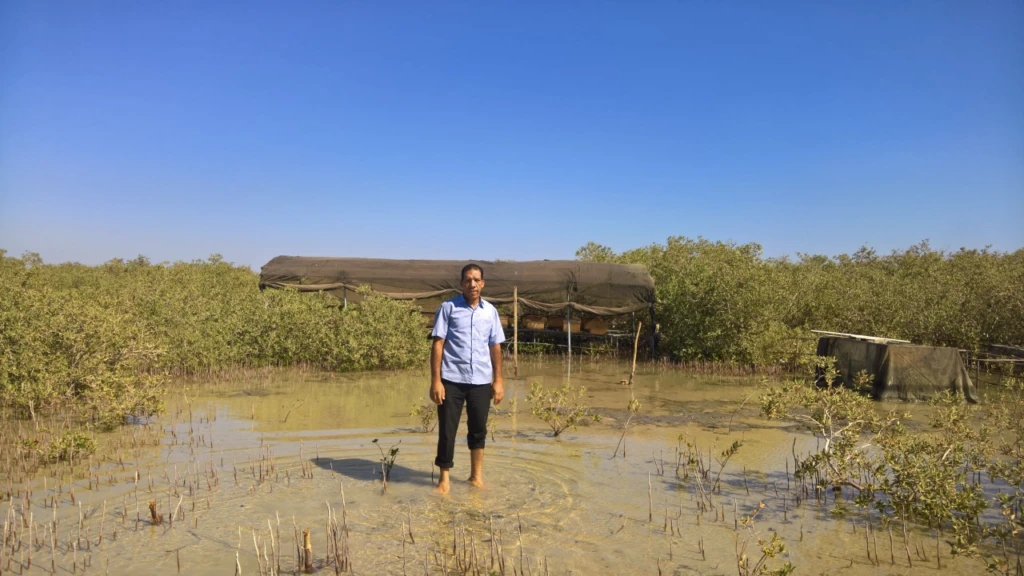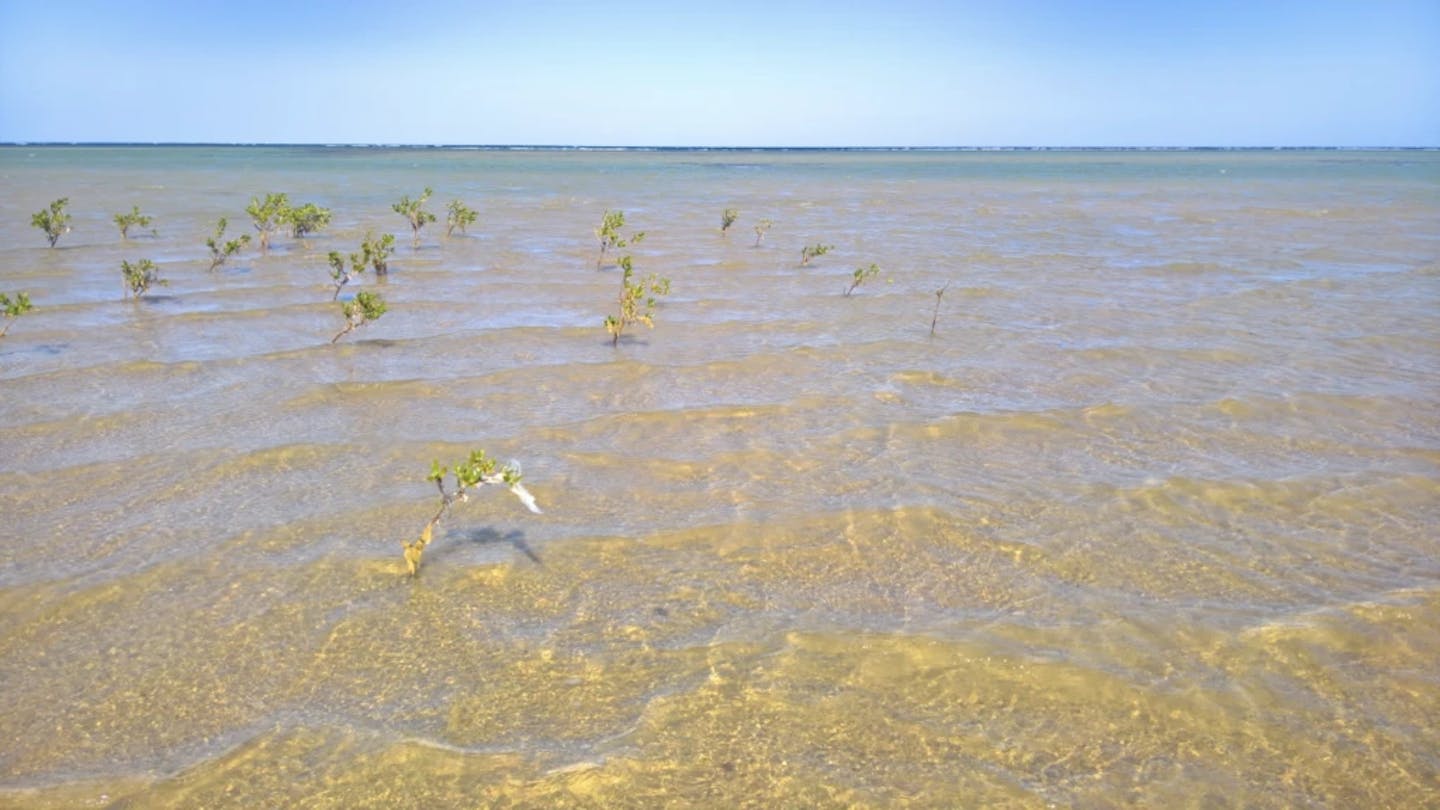A sweet solution: bees are saving threatened mangroves in Egypt
- Nature Conservation
- Ecosystem Restoration
- Mangrove Restoration
- Wetland Restoration
- Biodiversity
- Policy & Governance
- Pollinators
- Insects
- North Africa
- Southern Eurasia Realm
Every few days, Dr. Mahmoud Abbas crosses the road from Qena Governorate, where he lives, to the city of Safaga to supervise the apiary located among the mangroves in the Red Sea. Dr. Abbas works as a professor for the Department of Plant Protection at South Valley University in Egypt.
In the first quarter of 2020, the Egyptian government began a project to plant mangroves and rehabilitate six areas on the Egyptian coast of the Red Sea. The initiative intends to cover 210 hectares by planting 50,000 small plant seedlings every year.
An apiary was also established in Safaga for the production of honey. For the dual purposes of helping recover the mangroves and providing locals with livelihoods.
Restoring the presence of mangroves has become a necessity all over the world. From 1980 to 2005, between 20-35% of the world’s mangrove forests were lost, according to the U.N. Food and Agriculture Organization.
The mangrove plantation project is part of a trend towards practices that mitigate the effects of climate change and increase communities’ ability to adapt. Mangroves are considered a guard of nature. They grow in saltwater and act as a barrier to sea level rise, protecting the beaches from erosion.
Solutions from this project could add to some of the ideas being discussed at the UN’s Climate Change Conference (COP26). Not only are leaders pledging to stop deforestation, but they’re also discussing ways to sequester more greenhouse gases out of the atmosphere.
This is where mangroves come in, as they’re capable of absorbing enormous amounts of carbon. Even though they make up only 3% of Earth’s forest cover, mangroves store four times more CO2 than terrestrial forests.

Dr. Mahmoud Abbas in his apiary located in the middle of a mangrove in Egypt. Image credit: Courtesy of Hadeer El-Hadary
Protecting mangroves with bees
Dr. Mahmoud Abbas supervises the 20 beehives in Safaga’s apiary. The bee yards help pollinate and fertilize the newly planted mangroves and create job opportunities for some residents in the area.
The bees feed on the nectar of two types of mangrove trees scattered on the city's coast to produce a rare type of honey. According to Dr. Mahmoud, this honey has a distinct flavor because the mangroves grow in saltwater. Also, because of this, the plants do not need freshwater irrigation or agricultural pesticides.
According to Dr. Mahmoud, the mangrove flowers bloom in the early winter months. Since this is usually a difficult period for bees due to the lack of blossoms, this is an additional advantage of the mangrove plantation.
Honey production is not without challenges, the first being the seasonality of production. As plants do not bloom all year round, a ‘mobile apiary’ has allowed the easy transfer of bees to other areas to feed on plants that bloom at different times, such as mountain plants. This solution enables bees to produce a more significant amount of honey.
The other challenge is the bees’ need for freshwater. The project organizers resolved this issue by placing large containers filled with fresh water and materials such as sponges, allowing the bees to drink.
Life blossoms
Dr. Mahmoud enjoys seeing the biodiversity of living creatures around the mangroves. He spots various types of butterflies, insects, and multiple fish species on his work visits. In addition, he sees many birds feeding on their migratory routes.
Mangrove forests contain some of the planet’s most biological diversity. They provide habitat for thousands of species worldwide, from bacteria to barnacles to Bengal tigers.
In Egypt, the area of mangrove forests is about 1,500 acres, according to Dr. Sayed Khalifa, the head of the Egyptian Agricultural Syndicate. Dr. Khalifa is the director of the mangrove project and sees multiple perks from it.
He described the mangrove trees as “natural barriers” protecting the shores of the Red Sea. As this shield is not available on the Mediterranean shores, the government is forced to make cement blocks to counter sea-level rise and protect cities.
Until 2005, some of the Egyptian population living around the mangrove forests brought their camels to feed on the trees, which led to their deterioration. According to Khalifa, the increase of awareness campaigns and the introduction of economic activities on the margins of the forests, such as the apiaries, have put an end to these practices.
“The benefits of mangroves are not limited to protecting the environment and nurturing living creatures, but they also hold important economic potential as a source of tourism and ecosystem services.”
— Dr. Sayed Khalifa, Head of the Egyptian Agricultural Syndicate
In another context, the mangrove planting project in Egypt could become an essential part of the “Green Middle East” initiative launched by Saudi Arabia. The goal is to plant 50 billion trees in the region.
Planting this vast number of trees will put significant pressure on water resources. The mangroves represent a vital contribution as they do not need irrigation and provide many environmental benefits.

